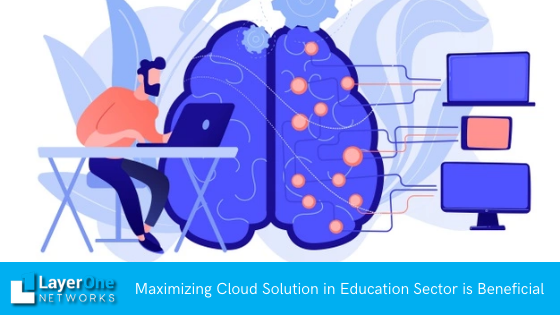
The demand for cloud services increases rapidly. The sector has been a key driver in bringing momentum from traditional on-premise applications to cloud-based SaaS solutions.
Modern educational institutions have welcomed a variety of applications and software which enables through cloud computing. Cloud adoption with the help of IT consulting firms helps them to provide modernized technology infrastructure. And it enhanced the student experience.
Cloud adoption in the education sector has a significant impact on various segments. It includes student services, operational excellence, data management, business intelligence, and student learning analytics.
Maximizing cloud services in the education industry
The need for cloud computing is growing due to the exponential growth of data generated. It is from academic activities like research papers and student assignments. The information is stored on a centralized server so that you can access it anytime, anywhere by the students and faculty.
Through cloud computing, it shares resources with its international counterpart. And it does not need to invest in thousands of dollars worth of hardware and software costs.
It is an ideal solution for the education sector to reduce IT services spending. And focus on other critical business initiatives.
This is good news for both Microsoft and Google, as they are the major players in the cloud computing business. Now Industry observers are watching to see whether the big winner will be Microsoft or Google?
At present, both these companies have a significant presence in the education sector. However, a deeper analysis reveals that Google has a larger share of mind in the education sector. And it is evident how Google has worked attentively to build out its capabilities in the cloud computing space. While at the same time creating a unique and differentiated value proposition in analytics and machine learning.
Cloud-based solutions are cost-savings
There is a need for flexible platforms to support diverse application needs. It ranges from simple document sharing to complex business collaboration. For example, the use of Microsoft Office 365 in educational institutions has increased by 400% in the last 3 years.
Cloud computing helps educational institutions to enable an “anytime-anywhere” learning experience. It also offers high-quality digital educational content to students.
It provides facilities like data analytics, business intelligence, and learning analytics. And It helps institutions know how their students learn best and improve student outcomes and market share.
Provides a wide array of opportunities
Cloud computing is also helpful for institutions to reduce their managed IT services costs. By migrating on-premise software licenses into cloud-based solutions. It can provide anywhere access at any time. Further, the digital presence of educational institutions enables students to learn anytime and everywhere. Thus it promotes lifelong learning concepts.
It will also promote global education opportunities. And help educational institutions for creating new business models with unique customer propositions.
Mobile Learning
According to research, the mobile workforce will quadruple by 2020. And over 50% of the world’s population is expected to own a smartphone within the next 5 years.
It will trigger the best adoption of cloud solutions to enable an anytime-anywhere learning experience. Educational institutions need to adopt cloud computing with the growing number of mobile devices (smartphones, tablets). It provides efficient mobile-first experiences to students. They can access learning resources at any time and from anywhere using their phones or laptops.
The recent forecast by Gartner Inc. shows that educational institutions maximize their revenues and improve student outcomes.
Huge benefits of cloud computing in education
- Decrease the total cost of ownership.
- A renewed education system with modern teaching practices.
- Enable anytime-anywhere learning environment for students.
- Improve existing schedules with a cloud-based solution.
- Boost up educational campus security with an automated and centralized enterprise information management system that ensures the security of student data.
- Enhance collaboration between students and teachers with an online collaboration platform that helps share educational resources among peers and helps faculty members share their expertise virtually.
- Boost collaborative learning experience for students and faculty.
- Ease distance and virtual education programs for students who cannot afford to be present on campus.
- Maximizing cloud solutions in the education sector will result in a rapid decision-making process. And it provides real-time data to assess the performance of existing teachers. And improve them through teacher training programs.
- It increases student retention rates by providing innovative practice opportunities for students. Those who cannot afford expensive tuition fees or do not have access to the best faculty.
Entire data and files of educational institutions can be stored and managed in a cloud-based environment. They have backed up at regular intervals and are protected from any kind of data loss due to natural disasters or human errors.
The usefulness of cloud computing in Distance Learning and Virtual Education
Cloud computing solutions can help institutions to offer a virtual climate to students. They cannot afford expensive tuition fees or do not have access to the best faculty.
Hybrid cloud offers you great benefits. Because the right cloud platform can do business intelligence, predictive analysis, and machine learning. It helps in making learning more personalized.
For example, the fast-growing use of this technology has enabled the education sector to move towards adaptive learning. It is where a student’s ability is analyzed. And instructional material issues rely on this assessment. Also, machine learning techniques are used in machine automated scoring. Also, with new generation text analysis tools and predictive analytic engines for GCI scorecards.
In Conclusion
The benefits of cloud computing in the education sector are tremendous. It will help improve existing schedules with a cloud-based solution. And boost educational campus security with enhanced collaboration among students and faculty members.
Above all, it is expected that by 2022 educational institutions will entirely rely on cloud computing to provide an anytime-anywhere learning experience to students. If you need help with analytics, learning management, an IT consulting firm is there to help you with cloud computing integration today.





